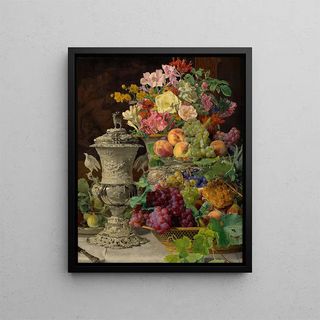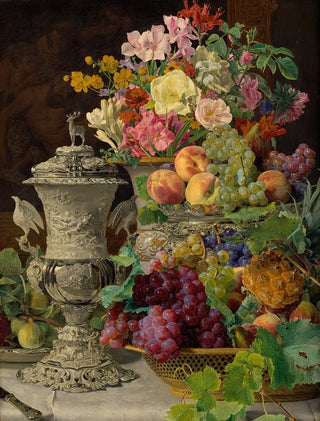Art print | Still life with fruits, flowers, and silver bowl - Ferdinand Georg Waldmüller


View from behind

Frame (optional)
Art print of Still Life with Fruits, Flowers, and Silver Bowl - Ferdinand Georg Waldmüller – Captivating Introduction
The still life, an emblematic genre of painting, finds in the work of Ferdinand Georg Waldmüller a particularly refined expression. "Still Life with Fruits, Flowers, and Silver Bowl" is part of a tradition that celebrates the ephemeral beauty of natural elements. This piece, imbued with delicacy and realism, invites the viewer to silent contemplation, where every detail seems to tell a story. The vibrant colors of the fruits, the texture of the petals, and the shine of the silver metal combine to create a visual harmony that captures attention and awakens the senses. Waldmüller, through this composition, offers us a window into a world where nature and art coexist in perfect symbiosis.
Style and uniqueness of the work
Waldmüller's style is distinguished by its meticulous realism and keen sense of observation. In this still life, each element is carefully arranged, demonstrating technical mastery that borders on virtuosity. The fruits, bursting with freshness, seem almost ready to be picked, while the flowers, with their delicate nuances, add a dimension of fragility to the whole. The silver bowl, brilliantly rendered, plays a central role, reflecting light and creating a striking contrast with the organic materials. This play of textures and reflections gives the artwork depth and visual richness that captivate the eye. Waldmüller thus manages to transcend mere representation to offer a true sensory experience, where the eye is guided through a ballet of shapes and colors.
The artist and his influence
Ferdinand Georg Waldmüller, an emblematic figure of 19th-century Austria, knew how to mark his era with an innovative approach to painting. Influenced by the Romantic movement, he distanced himself from academic conventions to explore more personal and introspective themes. His passion for nature, combined with a keen aesthetic sense, allowed him to create works that still resonate today. Waldmüller also played a key role in the development of realism in painting, emphasizing everyday subjects

Matte finish

View from behind

Frame (optional)
Art print of Still Life with Fruits, Flowers, and Silver Bowl - Ferdinand Georg Waldmüller – Captivating Introduction
The still life, an emblematic genre of painting, finds in the work of Ferdinand Georg Waldmüller a particularly refined expression. "Still Life with Fruits, Flowers, and Silver Bowl" is part of a tradition that celebrates the ephemeral beauty of natural elements. This piece, imbued with delicacy and realism, invites the viewer to silent contemplation, where every detail seems to tell a story. The vibrant colors of the fruits, the texture of the petals, and the shine of the silver metal combine to create a visual harmony that captures attention and awakens the senses. Waldmüller, through this composition, offers us a window into a world where nature and art coexist in perfect symbiosis.
Style and uniqueness of the work
Waldmüller's style is distinguished by its meticulous realism and keen sense of observation. In this still life, each element is carefully arranged, demonstrating technical mastery that borders on virtuosity. The fruits, bursting with freshness, seem almost ready to be picked, while the flowers, with their delicate nuances, add a dimension of fragility to the whole. The silver bowl, brilliantly rendered, plays a central role, reflecting light and creating a striking contrast with the organic materials. This play of textures and reflections gives the artwork depth and visual richness that captivate the eye. Waldmüller thus manages to transcend mere representation to offer a true sensory experience, where the eye is guided through a ballet of shapes and colors.
The artist and his influence
Ferdinand Georg Waldmüller, an emblematic figure of 19th-century Austria, knew how to mark his era with an innovative approach to painting. Influenced by the Romantic movement, he distanced himself from academic conventions to explore more personal and introspective themes. His passion for nature, combined with a keen aesthetic sense, allowed him to create works that still resonate today. Waldmüller also played a key role in the development of realism in painting, emphasizing everyday subjects






